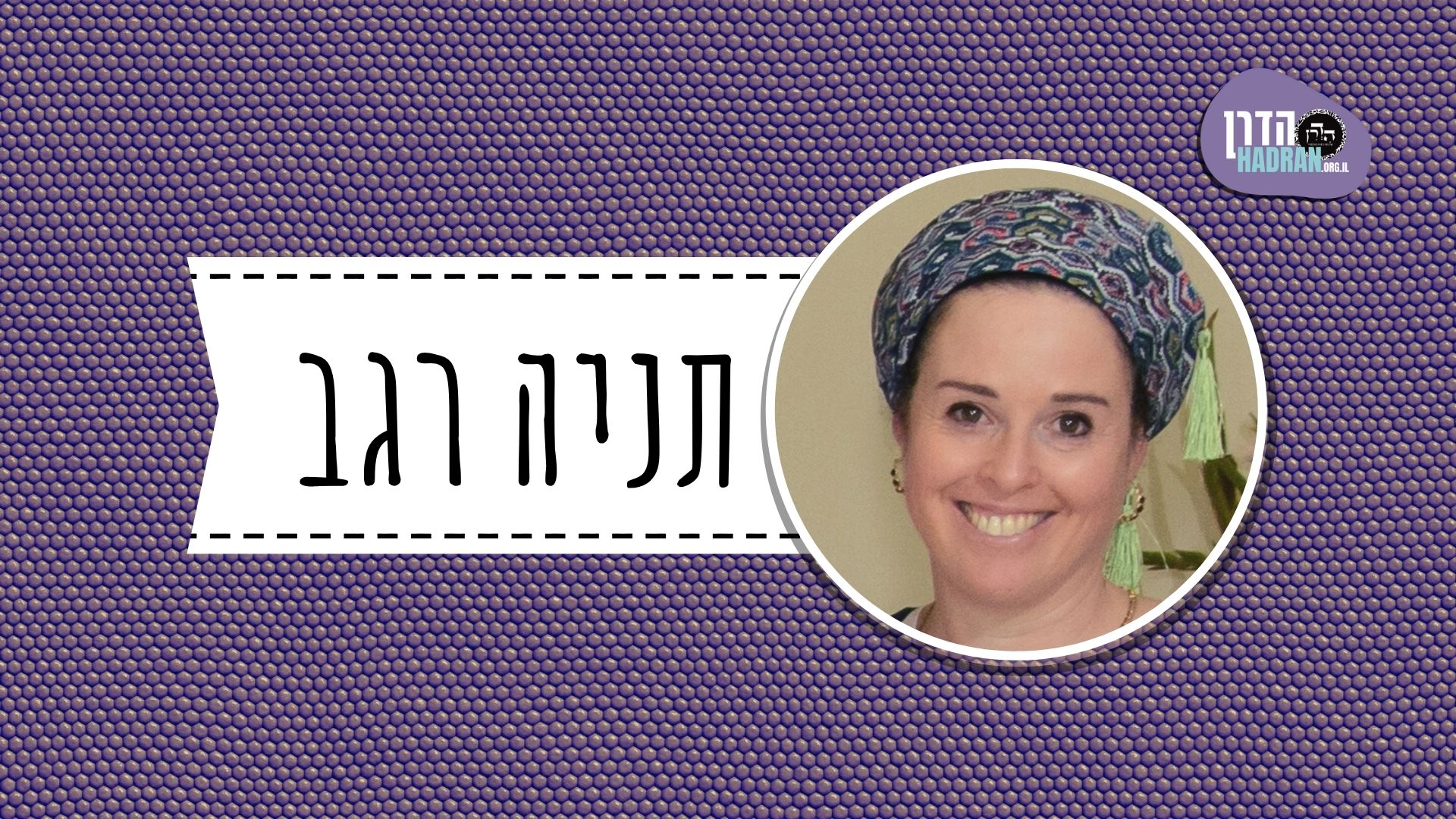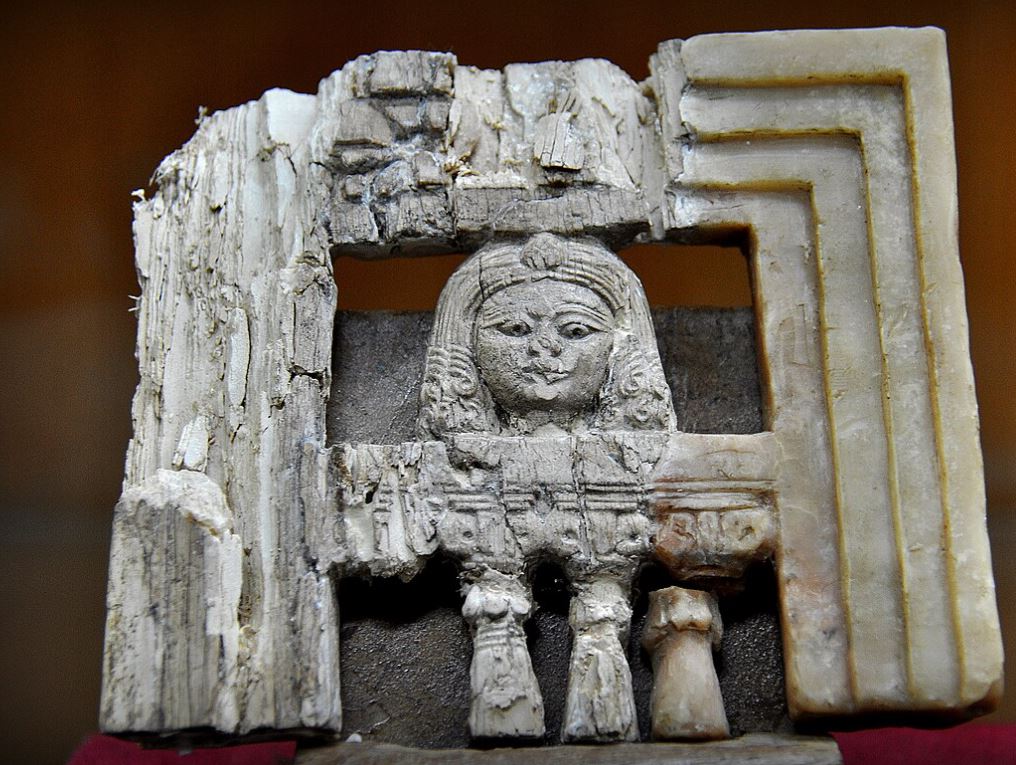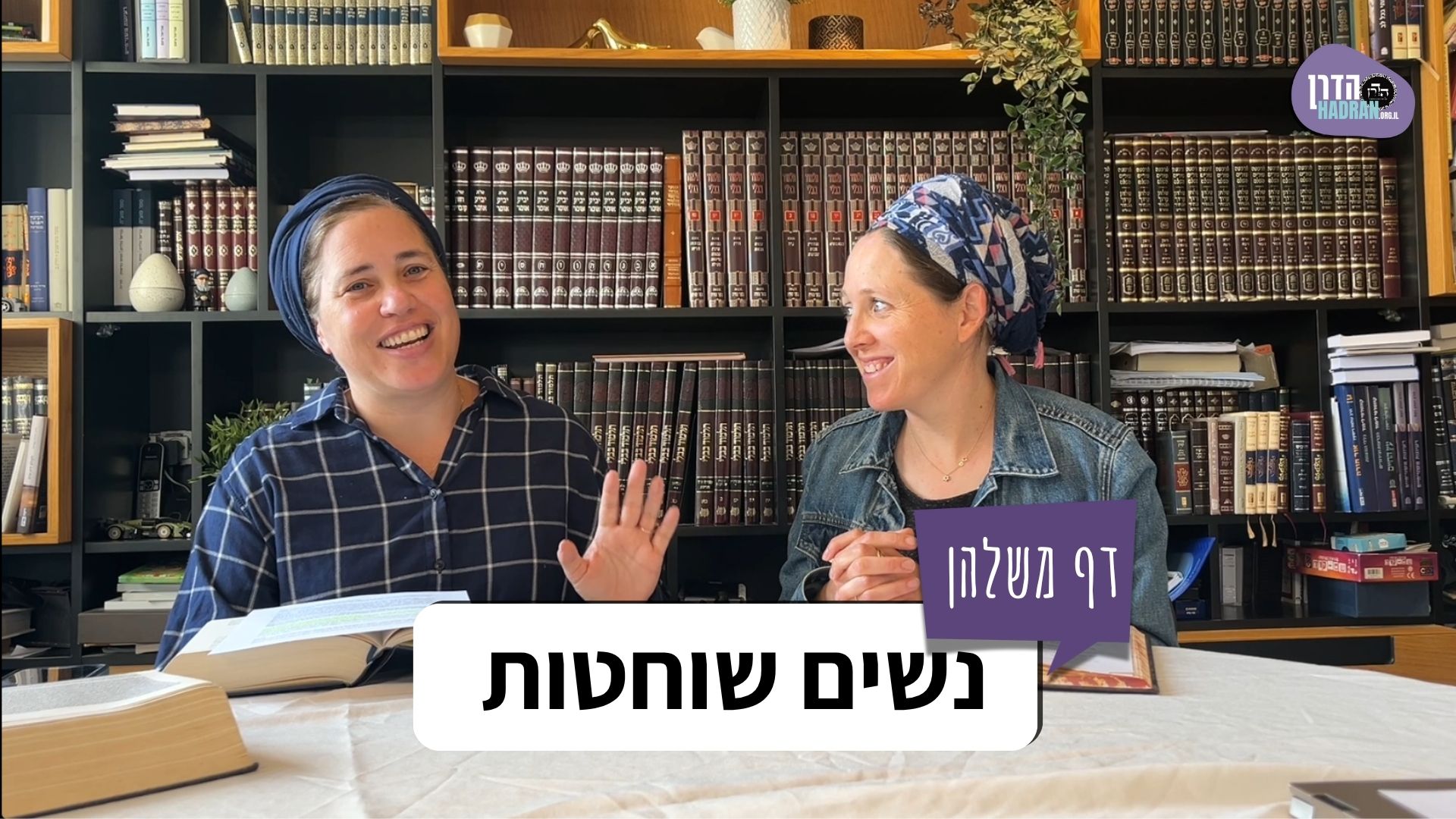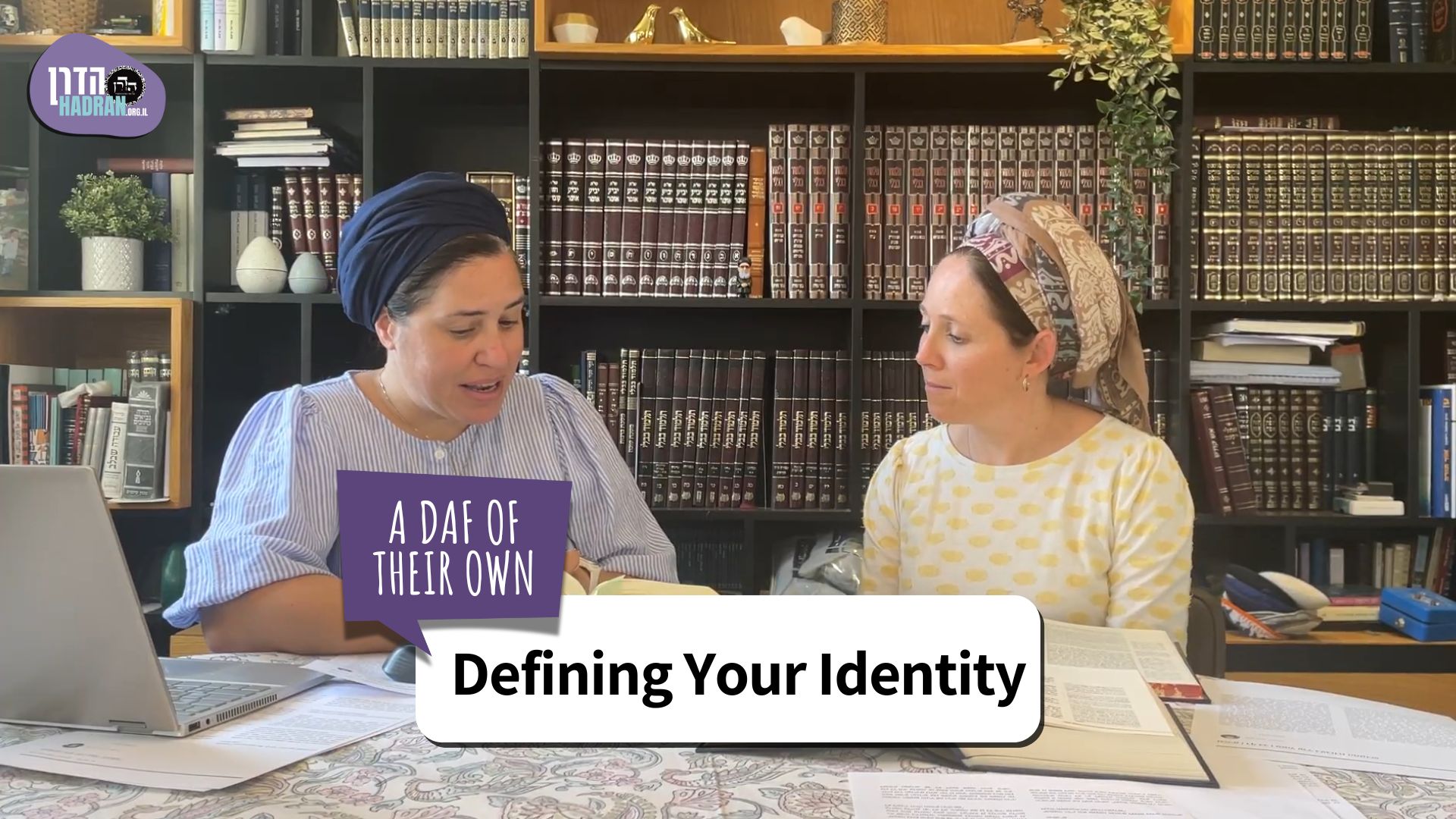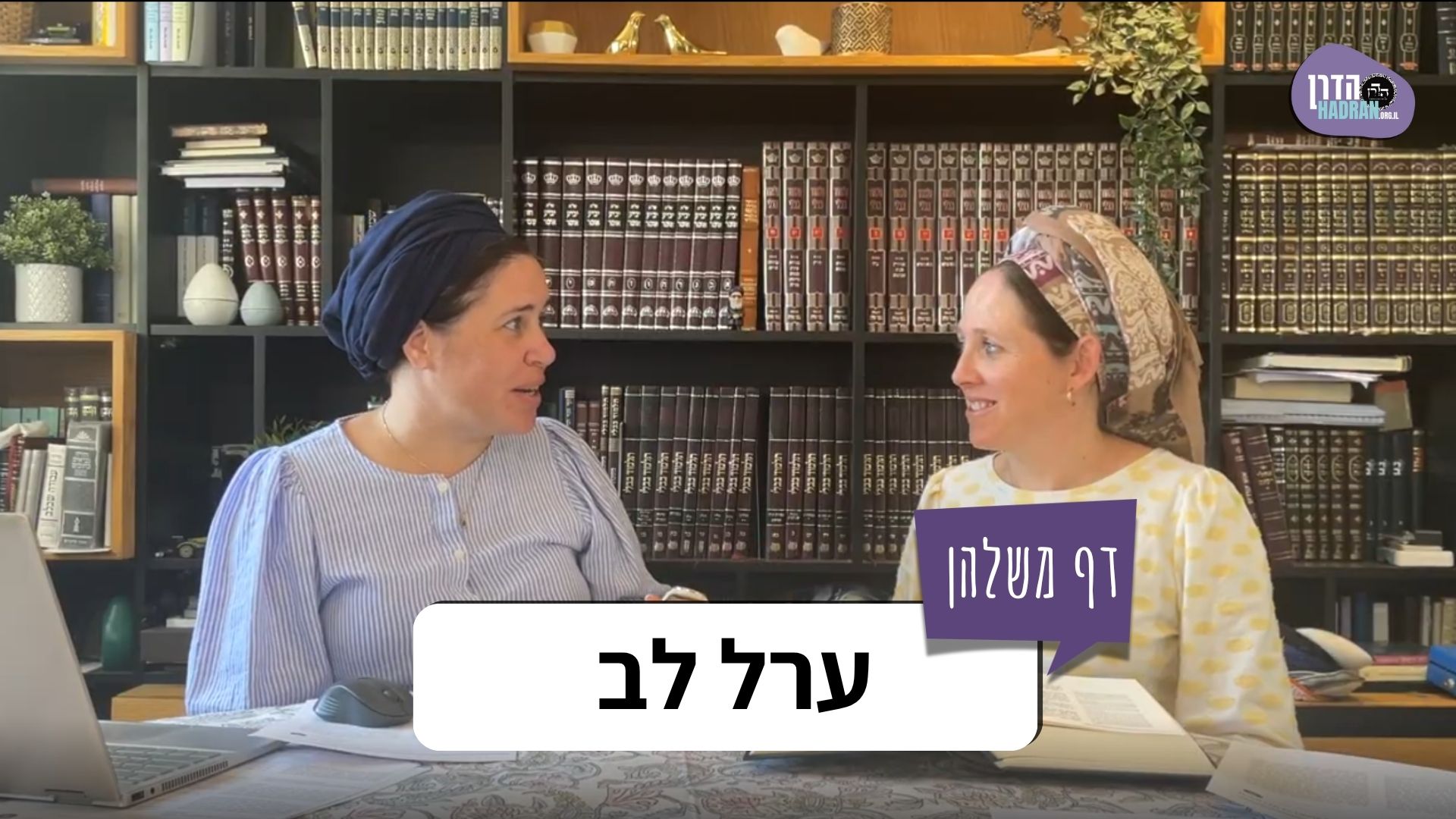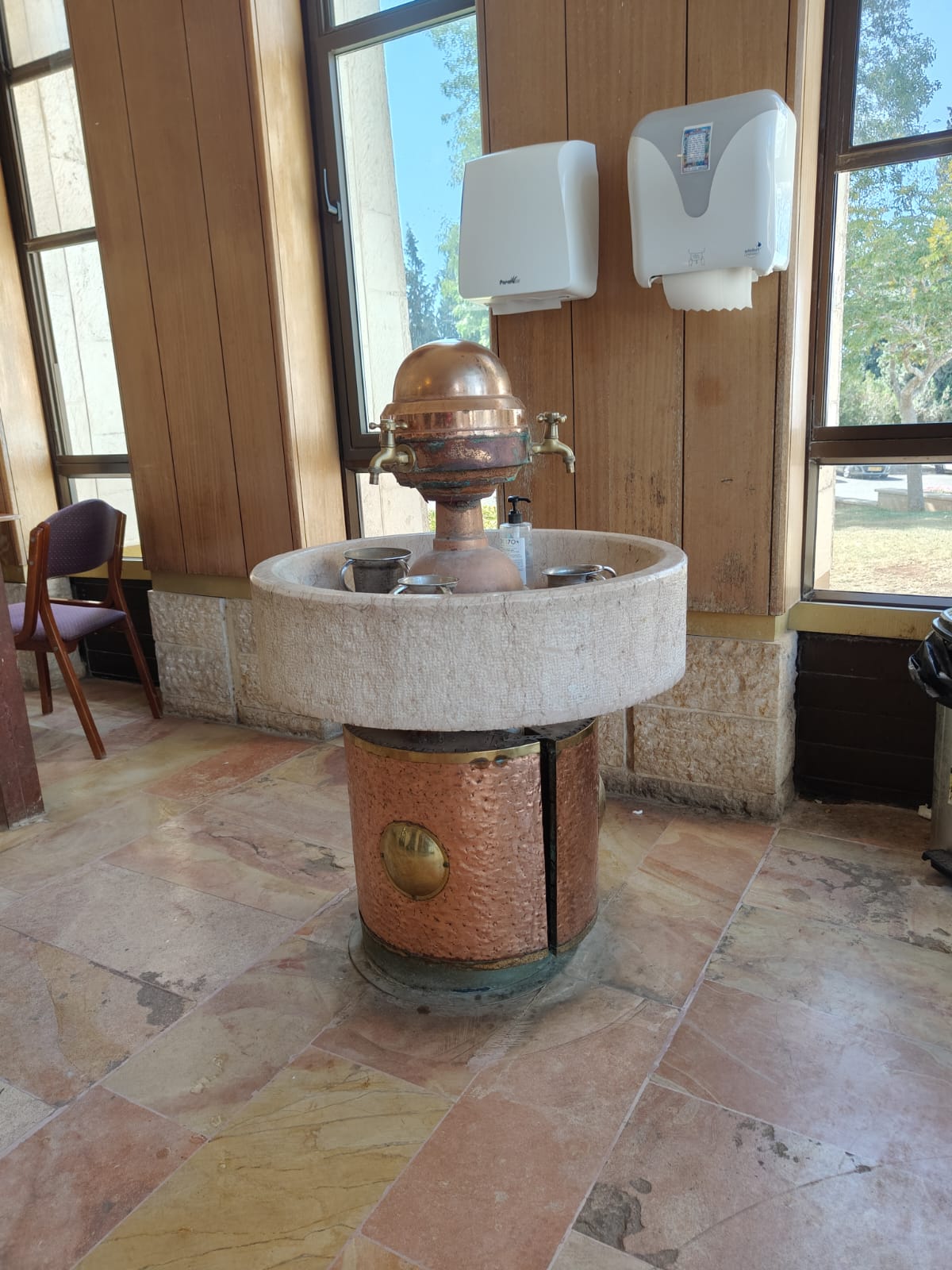פסחים סד
קַשְׁיָא מְלִיקָה אַמְּלִיקָה, קַשְׁיָא הַקְטָרָה אַהַקְטָרָה!
There seems to be a contradiction between the ruling in the first baraita with regard to pinching and the ruling in the second baraita with regard to pinching. In addition, there seems to be a contradiction between the ruling in the first baraita with regard to burning and the ruling in the second baraita with regard to burning. The first baraita rules that one who burns the sacrificial parts is included in the prohibition but that one who pinches the neck of a bird-offering is not, and the second baraita says the opposite.
וּלְטַעְמָיךְ, תִּיקְשֵׁי לָךְ הִיא גּוּפָא. דְּקָתָנֵי: לֹא אָמְרוּ אֶלָּא בְּפֶסַח בִּלְבַד, וַהֲדַר תָּנֵי: אֶחָד הַשּׁוֹחֵט וְאֶחָד הַזּוֹרֵק וְאֶחָד הַמּוֹלֵק וְאֶחָד הַמַּזֶּה!
The Gemara responds: And according to your reasoning that both baraitot refer to the same issue, ask about the baraita itself, as first it teaches: They said that this prohibition applies only to the Paschal lamb, and then it teaches that whether he slaughters the animal or he sprinkles the blood, or he pinches a bird-offering, or he sprinkles the blood of the bird-offering onto the altar, he is liable. Pinching and sprinkling the bird’s blood apply to bird-offerings but not to the Paschal lamb.
אֶלָּא: הָא וְהָא רַבִּי שִׁמְעוֹן. מְלִיקָה אַמְּלִיקָה לָא קַשְׁיָא: כָּאן — בְּאַרְבָּעָה עָשָׂר, כָּאן — בְּחוּלּוֹ שֶׁל מוֹעֵד. וְאִידֵּי וְאִידֵּי רַבִּי שִׁמְעוֹן הִיא.
Rather, say instead that both this baraita and that baraita express the opinion of Rabbi Shimon. And there is no contradiction between the ruling in the first baraita about pinching and the ruling in the second baraita about pinching: Here, where it says that one who pinches does not transgress, it is referring to the fourteenth of Nisan, while there, where it says that one who pinches does transgress, it is talking about the intermediate days of the festival of Passover. And both this baraita and that baraita express the opinion of Rabbi Shimon, who maintains that the prohibition does not apply to other sacrifices on the fourteenth of Nisan but does apply to them during the intermediate days of Passover, as explained in the mishna.
הַקְטָרָה אַהַקְטָרָה נָמֵי לָא קַשְׁיָא — תַּנָּאֵי הִיא. דְּאִיכָּא דְּמַקֵּישׁ הַקְטָרָה לִשְׁחִיטָה, וְאִיכָּא מַאן דְּלָא מַקֵּישׁ.
There is also no contradiction between the ruling in the first baraita about burning and the ruling in the second baraita about burning, as the matter is the subject of a dispute between tanna’im with regard to the opinion of Rabbi Shimon: There is one who compares burning to slaughtering, as Rav Pappa did, and there is one who does not compare them.
רַבִּי יְהוּדָה אוֹמֵר: אַף הַתָּמִיד וְכוּ׳. מַאי טַעְמָא דְּרַבִּי יְהוּדָה? אָמַר לָךְ: ״זִבְחִי״ — זֶבַח הַמְיוּחָד לִי, וּמַאי נִיהוּ? תָּמִיד.
It was stated in the mishna that Rabbi Yehuda says: One is liable even for slaughtering the daily afternoon offering on the eve of Passover with leaven in his possession. What is the reason for Rabbi Yehuda’s opinion? The Gemara answers: He could have said to you that the verse states: “You shall not offer the blood of My sacrifice with leavened bread” (Exodus 34:25). “My sacrifice” indicates the sacrifice that is designated to Me; and what is it? This is referring to the daily offering, which is a burnt-offering brought each day as part of the Temple service.
רַבִּי שִׁמְעוֹן אוֹמֵר: הַפֶּסַח בְּאַרְבָּעָה עָשָׂר וְכוּ׳. מַאי טַעְמָא דְּרַבִּי שִׁמְעוֹן? דִּכְתִיב ״זִבְחִי״ ״זִבְחִי״ תְּרֵי זִמְנֵי, קְרִי בֵּיהּ: ״זֶבַח, זְבָחַיי״.
It was further stated in the mishna that Rabbi Shimon says: On the fourteenth of Nisan one is liable for sacrificing the Paschal lamb with leaven in his possession, but he is not liable for sacrificing other offerings with leaven; however, during the Festival one is liable for sacrificing any offering with leaven in his possession. The Gemara asks: What is the reason for Rabbi Shimon’s opinion? The Gemara answers: As it is written: “My sacrifice [zivḥi],” “My sacrifice [zivḥi],” two times, as first it is written: “You shall not offer the blood of My sacrifice [zivḥi] with leavened bread” (Exodus 23:18) and then it is written again: “You shall not offer the blood of My sacrifice [zivḥi] with leavened bread” (Exodus 34:25). If the two instances of the word zivḥi are combined, their letters may be rearranged to read: A sacrifice [zevaḥ], and: My sacrifices [zevaḥai]. This indicates that the law applies both to the Paschal lamb and to the rest of the sacrifices.
לְמַאי הִלְכְתָא פַּלְגִינְהוּ רַחֲמָנָא מֵהֲדָדֵי וְלָא כְּתַב ״זְבָחַיי״? לְמֵימַר: בִּזְמַן דְּאִיכָּא זֶבַח — לָא מִחַיַּיב אַזְּבָחַיי. בִּזְמַן דְּלֵיכָּא זֶבַח — מִחַיַּיב אַזְּבָחַיי.
To teach what halakha does the Merciful One divide them from one another and not explicitly write: My sacrifices? It was to say that at the time when there is a sacrifice, meaning at the time of the Paschal lamb, as mentioned in the continuation of the verse, one is not liable for My sacrifices. On the eve of Passover, when the Paschal lamb is brought, there is no liability for offering other sacrifices with leaven. However, at a time when there is no sacrifice, during the festival of Passover, one is liable for slaughtering any of My sacrifices with leaven in his possession.
וּבַמּוֹעֵד לִשְׁמוֹ פָּטוּר וְכוּ׳. טַעְמָא דְּשֶׁלֹּא לִשְׁמוֹ, הָא סְתָמָא — פָּטוּר.
It was taught in the mishna that according to Rabbi Shimon, if one sacrificed a Paschal lamb during the intermediate days of the Festival for its own purpose as a Paschal lamb, one is exempt from liability if he had leaven in his possession during the time of the slaughter, as it is an invalid offering. However, if he sacrificed it for a different purpose, he is liable, because a Paschal lamb that is slaughtered at a time other than Passover eve is valid as a peace-offering. The Gemara analyzes this ruling: The reason he is liable is that he slaughtered it explicitly for a different purpose; but had he slaughtered it without specific intent he would be exempt, because the offering would be disqualified. Unless he specifically states otherwise, the animal retains its status as a Paschal lamb and is subsequently disqualified because it is not the proper time to sacrifice a Paschal lamb.
אַמַּאי? פֶּסַח בִּשְׁאָר יְמוֹת הַשָּׁנָה שְׁלָמִים הָוֵי! שָׁמְעַתְּ מִינַּהּ פֶּסַח בִּשְׁאָר יְמוֹת הַשָּׁנָה בָּעֵי עֲקִירָה!
The Gemara expresses surprise: Why must he expressly state that he is sacrificing it as a different offering? Isn’t a Paschal lamb sacrificed during the rest of the days of the year presumed to be a peace-offering? There should be no need to state explicitly that it is a different offering. Learn from this that a Paschal lamb sacrificed on the rest of the days of the year requires uprooting, i.e., one must explicitly declare that he is sacrificing the offering as a peace-offering, and not as a Paschal lamb.
אָמַר רַבִּי חִיָּיא בַּר גַּמְדָּא: נִזְרְקָה מִפִּי חֲבוּרָה, וְאָמְרוּ: כְּגוֹן שֶׁהָיוּ בְּעָלִים טְמֵאֵי מֵת, וְנִדְחִין לְפֶסַח שֵׁנִי, דִּסְתָמֵיהּ לְשׁוּם פֶּסַח קָאֵי.
Rabbi Ḥiyya bar Gamda said: A group of scholars were studying this issue and it emerged from the group, that is, one of the scholars made a statement with which the rest of them agreed, and it was subsequently forgotten who had made the statement, and they said as follows: We are dealing here with a case where the owners of the offering were ritually impure with impurity imparted by a corpse during the first Passover, and they were deferred to the second Passover. A person who was ritually impure or on a distant journey and therefore failed to bring the Paschal lamb at its proper time on the fourteenth of Nisan must compensate by bringing the offering on the fourteenth of Iyyar. In such a situation, the offering presumably stands to be sacrificed as a Paschal lamb, and it does not automatically become a peace-offering unless its owners explicitly declare it as such. However, this would not be true of other Paschal lambs after the time to offer the Paschal lamb has passed.
מַתְנִי׳ הַפֶּסַח נִשְׁחַט בְּשָׁלֹשׁ כִּתּוֹת, שֶׁנֶּאֱמַר: ״וְשָׁחֲטוּ אוֹתוֹ כֹּל קְהַל עֲדַת יִשְׂרָאֵל״, קָהָל, וְעֵדָה, וְיִשְׂרָאֵל. נִכְנְסָה כַּת הָרִאשׁוֹנָה, נִתְמַלְּאָה הָעֲזָרָה, נָעֲלוּ דַּלְתוֹת הָעֲזָרָה, תָּקְעוּ הֵרִיעוּ וְתָקְעוּ,
MISHNA: The Paschal lamb was slaughtered in three groups, meaning those bringing the offering were divided into three separate sets, as it is stated: “And the whole assembly of the congregation of Israel shall slaughter it in the afternoon” (Exodus 12:6). The verse is interpreted as referring to three groups: Assembly, congregation, and Israel. The procedure for sacrificing the offering was as follows: The first group of people sacrificing the offering entered, and when the Temple courtyard became filled with them they closed the doors of the Temple courtyard. They sounded uninterrupted, broken, and uninterrupted trumpet blasts, as was done while sacrificing any offering.
הַכֹּהֲנִים עוֹמְדִים שׁוּרוֹת שׁוּרוֹת, וּבִידֵיהֶם בְּזִיכִי כֶסֶף וּבְזִיכֵי זָהָב. שׁוּרָה שֶׁכּוּלָּהּ כֶּסֶף כֶּסֶף, וְשׁוּרָה שֶׁכּוּלָּהּ זָהָב זָהָב, לֹא הָיוּ מְעוֹרָבִין. וְלֹא הָיוּ לַבָּזִיכִין שׁוּלַיִים, שֶׁמָּא יַנִּיחוּם וְיִקָּרֵשׁ הַדָּם.
The priests stood in rows from the place of slaughter to the altar, and in their hands they held bowls [bezikhin] of silver and bowls of gold in order to receive the blood of the offerings. There was a row entirely composed of priests holding silver bowls, and a row entirely composed of priests holding gold bowls, as the gold and silver bowls were not mixed in the same row. The bowls did not have flat bases that would allow them to be put down, out of concern that perhaps the priests would set them down and forget about them and in the meantime the blood would congeal and become disqualified for sprinkling on the altar.
שָׁחַט יִשְׂרָאֵל, וְקִבֵּל הַכֹּהֵן. נוֹתְנוֹ לַחֲבֵירוֹ, וַחֲבֵירוֹ לַחֲבֵירוֹ. וּמְקַבֵּל אֶת הַמָּלֵא, וּמַחֲזִיר אֶת הָרֵיקָן. כֹּהֵן הַקָּרוֹב אֵצֶל הַמִּזְבֵּחַ זוֹרְקוֹ זְרִיקָה אַחַת כְּנֶגֶד הַיְּסוֹד.
An Israelite would slaughter the sacrifice, and a priest would receive the blood and immediately hand it to another priest standing next to him, and the other priest would pass it to another. Each priest would receive a full bowl of blood from the priest next to him and return to him an empty bowl being passed in the opposite direction, the contents of which had already been sprinkled on the altar. The priest who was closest to the altar would sprinkle a single sprinkling of blood against the base of the altar, i.e., against the north and west sides of the altar, where there was a base.
יָצְתָה כַּת רִאשׁוֹנָה, וְנִכְנְסָה כַּת שְׁנִיָּה. יָצְתָה שְׁנִיָּה, נִכְנְסָה שְׁלִישִׁית. כְּמַעֲשֵׂה הָרִאשׁוֹנָה כָּךְ מַעֲשֵׂה הַשְּׁנִיָּה וְהַשְּׁלִישִׁית. קָרְאוּ אֶת הַהַלֵּל. אִם גָּמְרוּ — שָׁנוּ, וְאִם שָׁנוּ — שִׁלֵּשׁוּ, אַף עַל פִּי שֶׁלֹּא שִׁלְּשׁוּ מִימֵיהֶם. רַבִּי יְהוּדָה אוֹמֵר: מִימֵיהֶם שֶׁל כַּת שְׁלִישִׁית לֹא הִגִּיעוּ לְ״אָהַבְתִּי כִּי יִשְׁמַע ה׳״, מִפְּנֵי שֶׁעַמָּהּ מוּעָטִין.
The first group exited upon completion of the rite, and the second group entered; the second group left upon completion of its rite, and the third group entered. As it was done by the first group, so was it done by the second and third groups. All the people standing in the Temple courtyard while the Paschal lambs were being slaughtered would recite hallel. If they finished reciting it before all the offerings were slaughtered, they recited it a second time, and if they finished reciting it a second time, they recited it a third time, although in practice they never recited it a third time, as the priests worked efficiently and finished the rite before this became necessary. Rabbi Yehuda says: The third group never reached even once the opening verse of the fourth chapter of hallel: “I love that the Lord hears the voice of my supplications” (Psalms 116:1), because its people were few and the slaughtering of all the offerings was completed during the recitation of the first three chapters.
כְּמַעֲשֵׂהוּ בַּחוֹל כָּךְ מַעֲשֵׂהוּ בַּשַּׁבָּת, אֶלָּא שֶׁהַכֹּהֲנִים מְדִיחִים אֶת הָעֲזָרָה שֶׁלֹּא בִּרְצוֹן חֲכָמִים. רַבִּי יְהוּדָה אוֹמֵר: כּוֹס הָיָה מְמַלֵּא מִדַּם הַתַּעֲרוֹבֶת, זְרָקוֹ זְרִיקָה אַחַת עַל גַּבֵּי הַמִּזְבֵּחַ. וְלֹא הוֹדוּ לוֹ חֲכָמִים.
As it was done during the week, so was it done on Shabbat; only that on Shabbat the priests would rinse the Temple courtyard, cleaning away the blood, contrary to the wishes of the Sages, as the priests did not want to veer from the weekday procedure in this regard. Rabbi Yehuda says: Before the floor was rinsed, a priest would fill a cup with the blood of the many offerings brought that day that was now mixed together on the floor and then sprinkle it with a single sprinkling upon the altar. But the Rabbis did not agree with Rabbi Yehuda with regard to this point.
כֵּיצַד תּוֹלִין וּמַפְשִׁיטִין? אוּנְקְלָיוֹת שֶׁל בַּרְזֶל הָיוּ קְבוּעִים בַּכְּתָלִים וּבָעַמּוּדִים שֶׁבָּהֶן תּוֹלִין וּמַפְשִׁיטִין. כׇּל מִי שֶׁאֵין לוֹ מָקוֹם לִתְלוֹת וּלְהַפְשִׁיט — מַקְלוֹת דַּקִּים וַחֲלָקִים הָיוּ שָׁם, מַנִּיחַ עַל כְּתֵפוֹ וְעַל כֶּתֶף חֲבֵירוֹ, וְתוֹלֶה וּמַפְשִׁיט. רַבִּי אֱלִיעֶזֶר אוֹמֵר: אַרְבָּעָה עָשָׂר
How would one suspend and flay the Paschal lamb in the Temple? Iron hooks [unkelayot] were secured into the walls and pillars, and upon them one would suspend the offering and flay it. If anyone lacked a place among the hooks in the Temple courtyard to suspend and flay the offering, there were thin, smooth rods there, which he would place on his own shoulder and on another’s shoulder, and from it he would suspend the offering and flay it. Rabbi Eliezer says: When the fourteenth of Nisan
שֶׁחָל לִהְיוֹת בַּשַּׁבָּת, מַנִּיחַ יָדוֹ עַל כֶּתֶף חֲבֵירוֹ, וְיַד חֲבֵירוֹ עַל כְּתֵיפוֹ, וְתוֹלֶה וּמַפְשִׁיט. קְרָעוֹ, וְהוֹצִיא אֶת אֵימוּרָיו. נְתָנוֹ בְּמָגֵיס, וְהִקְטִירָן עַל גַּבֵּי הַמִּזְבֵּחַ.
occurred on Shabbat, when moving the rods is prohibited (Rambam), he would rest his hand on another’s shoulder and the other’s hand on his own shoulder and suspend the offering and flay it. He would tear open the flesh of the offering and remove its sacrificial parts, i.e., the fats and other parts offered on the altar. He would place the sacrificial parts in a large basin [mageis] and burn them on the altar.
יָצְתָה כַּת הָרִאשׁוֹנָה וְיָשְׁבָה לָהּ בְּהַר הַבַּיִת. שְׁנִיָּה בַּחֵיל, וְהַשְּׁלִישִׁית בִּמְקוֹמָהּ עוֹמֶדֶת. חָשֵׁיכָה — יָצְאוּ וְצָלוּ אֶת פִּסְחֵיהֶן.
If this took place on Shabbat, when carrying is prohibited, the first group would exit and remain on the Temple Mount; the second group would remain within the rampart, which was an area outside the women’s courtyard; and the third group would stand in its place in the Temple. They would wait there until nightfall, and as soon as it became dark, they would all go out and roast their Paschal lambs, everyone in his own place.
גְּמָ׳ אָמַר רַבִּי יִצְחָק: אֵין הַפֶּסַח נִשְׁחָט אֶלָּא בְּשָׁלֹשׁ כִּתּוֹת שֶׁל שְׁלֹשִׁים שְׁלֹשִׁים בְּנֵי אָדָם. מַאי טַעְמָא? ״קָהָל״ וְ״עֵדָה״ וְ״יִשְׂרָאֵל״. מְסַפְּקָא לַן אִי בְּבַת אַחַת אִי בְּזֶה אַחַר זֶה,
GEMARA: Rabbi Yitzḥak said: The Paschal lamb is slaughtered only in three groups of at least thirty people each. What is the reason for this rule? The verse says: Assembly, congregation, and Israel, and each of these terms refers to a group of no fewer than ten people. We are uncertain as to whether this means that we need three groups of ten people at the same time or one after another.
הִלְכָּךְ בָּעֵינַן שָׁלֹשׁ כִּתּוֹת שֶׁל שְׁלֹשִׁים שְׁלֹשִׁים בְּנֵי אָדָם. דְּאִי בְּבַת אַחַת — הָא אִיכָּא, וְאִי בָּזֶה אַחַר זֶה — הָא אִיכָּא, הִלְכָּךְ בְּחַמְשִׁין נָמֵי סַגִּיא, דְּעָיְילִי תְּלָתִין וְעָבְדִי, עָיְילִי עַשְׂרָה וְנָפְקִי עַשְׂרָה, עָיְילִי עַשְׂרָה וְנָפְקִי עַשְׂרָה.
Therefore, in order to satisfy both possible interpretations, we require three groups of thirty people each. As, if you say we need all thirty at the same time, we have that, and if we need them one after another, we have that as well. Therefore, in pressing circumstances when there are not enough people present, even fifty people suffice. How so? Thirty enter and perform the necessary rite, ten others enter and ten of the original group leave so that those present are considered a new group, and then ten others enter and ten more leave so that those present now comprise a third group. In this way the Paschal lamb is slaughtered in three groups of thirty people each, although the total number of people involved is only fifty.
נִכְנְסָה כַּת רִאשׁוֹנָה וְכוּ׳. אִיתְּמַר, אַבָּיֵי אָמַר: נִנְעֲלוּ תְּנַן. רָבָא אָמַר: נוֹעֲלִין תְּנַן.
The mishna teaches that the first group entered, after which they closed the doors to the Temple courtyard. It was stated that the amora’im disagreed about the precise wording of the mishna. Abaye said: We learned in the mishna that the doors of the Temple courtyard miraculously closed by themselves. Rava said: We learned in the mishna that people would close the doors of the Temple courtyard at the appropriate time.
מַאי בֵּינַיְיהוּ? אִיכָּא בֵּינַיְיהוּ לְמִסְמַךְ אַנִּיסָּא. אַבָּיֵי אָמַר: נִנְעֲלוּ תְּנַן, כַּמָּה דַּעֲיַילוּ מְעַלּוּ, וְסָמְכִינַן אַנִּיסָּא. רָבָא אָמַר: נוֹעֲלִין תְּנַן, וְלָא סָמְכִינַן אַנִּיסָּא.
What is the practical difference between them? The practical difference between them is with regard to whether we rely on a miracle. Abaye said: We learned in the mishna that the doors closed by themselves; as many people as entered, entered, and we rely on a miracle to close the doors so that an excessive number of people not enter and thus create a danger (Rabbeinu Ḥananel). Rava said: We learned in the mishna that people would close the doors, and we do not rely on a miracle to ensure that the courtyard not become overly crowded.
וְהָא דִּתְנַן, אָמַר רַבִּי יְהוּדָה: חַס וְשָׁלוֹם שֶׁעֲקַבְיָא בֶּן מַהֲלַלְאֵל נִתְנַדָּה, שֶׁאֵין עֲזָרָה נִנְעֶלֶת עַל כׇּל אָדָם בְּיִשְׂרָאֵל בְּחׇכְמָה וּבְיִרְאַת חֵטְא כַּעֲקַבְיָא בֶּן מַהֲלַלְאֵל. אַבָּיֵי מְתָרֵץ לְטַעְמֵיהּ, וְרָבָא מְתָרֵץ לְטַעְמֵיהּ. אַבָּיֵי מְתָרֵץ לְטַעְמֵיהּ: אֵין בָּעֲזָרָה בְּשָׁעָה שֶׁנִּנְעֲלָה עַל כׇּל אָדָם בְּיִשְׂרָאֵל בְּחׇכְמָה וּבְיִרְאַת חֵטְא כַּעֲקַבְיָא בֶּן מַהֲלַלְאֵל: רָבָא מְתָרֵץ לְטַעְמֵיהּ: אֵין בָּעֲזָרָה בְּשָׁעָה שֶׁנּוֹעֲלִין אוֹתָהּ עַל כׇּל יִשְׂרָאֵל בְּחׇכְמָה וּבְיִרְאַת חֵטְא כַּעֲקַבְיָא בֶּן מַהֲלַלְאֵל.
And that which we learned elsewhere in a mishna with regard to the ban placed upon Akavya ben Mahalalel for having spoken harshly about Shemaya and Avtalyon, that Rabbi Yehuda said: Heaven forbid that Akavya ben Mahalalel was banned; it must have been someone else, as even when the entire Jewish people would come to Jerusalem for the Festival, the Temple courtyard would not close on any man from Israel as full of wisdom and fear of sin as Akavya ben Mahalalel; Abaye can explain this statement according to his opinion, and Rava can also explain it according to his opinion. Abaye can explain it according to his opinion as follows: No man from Israel was in the Temple courtyard when it closed by itself who was as full of wisdom and fear of sin as Akavya ben Mahalalel. Rava, too, can explain it according to his opinion as follows: No man from Israel was in the Temple courtyard when they closed it who was as full of wisdom and fear of sin as Akavya ben Mahalalel.
תָּנוּ רַבָּנַן: מֵעוֹלָם לָא נִתְמַעֵךְ אָדָם בָּעֲזָרָה, חוּץ מִפֶּסַח אֶחָד שֶׁהָיָה בִּימֵי הִלֵּל, שֶׁנִּתְמַעֵךְ בּוֹ זָקֵן אֶחָד, וְהָיוּ קוֹרְאִין אוֹתוֹ ״פֶּסַח מְעוּכִין״.
The Sages taught: No one was ever crushed by the great throngs of people in the Temple courtyard, except for one Passover in the days of Hillel when an old man was crushed, and they called that Passover the Passover of the crushed.
תָּנוּ רַבָּנַן: פַּעַם אַחַת בִּיקֵּשׁ אַגְרִיפַּס הַמֶּלֶךְ לִיתֵּן עֵינָיו בְּאוּכְלוּסֵי יִשְׂרָאֵל. אֲמַר לֵיהּ לְכֹהֵן גָּדוֹל: תֵּן עֵינֶיךָ בַּפְּסָחִים. נָטַל כּוּלְיָא מִכׇּל אֶחָד, וְנִמְצְאוּ שָׁם שִׁשִּׁים רִיבּוֹא זוּגֵי כְלָיוֹת כִּפְלַיִם כְּיוֹצְאֵי מִצְרַיִם. חוּץ מִטָּמֵא וְשֶׁהָיָה בְּדֶרֶךְ רְחוֹקָה. וְאֵין לָךְ כׇּל פֶּסַח וּפֶסַח שֶׁלֹּא נִמְנוּ עָלָיו יוֹתֵר מֵעֲשָׂרָה בְּנֵי אָדָם. וְהָיוּ קוֹרְאִין אוֹתוֹ ״פֶּסַח מְעוּבִּין״.
The Sages taught: Once, King Agrippa wished to set his eyes on the multitudes [ukhlosin] of Israel to know how many they were. He said to the High Priest: Set your eyes on the Paschal lambs; count how many animals are brought in order to approximate the number of people. The High Priest took a kidney from each one, as the kidneys are burned on the altar, and six hundred thousand pairs of kidneys were found there, double the number of those who left Egypt. This did not reflect the sum total of the Jewish people, as it excluded those who were ritually impure or at a great distance, who did not come to offer the sacrifice. Furthermore, this was a count of the Paschal lambs and not of the people, and there was not a single Paschal lamb that did not have more than ten people registered for it. They called that Passover the Passover of the crowded, due to the large number of people.
נָטַל כּוּלְיָא? הָא בָּעֵי אַקְטוּרַהּ! דַּהֲדַר מַקְטֵיר לְהוּ. וְהָכְתִיב: ״וְהִקְטִירוֹ״, שֶׁלֹּא יְעָרֵב חֲלָבָיו שֶׁל זֶה בָּזֶה!
The Gemara questions one of the details of this story: How could the High Priest take a kidney? Didn’t he have to burn it on the altar? The Gemara answers: He first took the kidneys for the count, and subsequently he burned them. The Gemara asks: Isn’t it written: “And the priest shall burn it on the altar; it is the food of the offering made by fire to the Lord” (Leviticus 3:11)? The singular “it” apparently indicates that he must not mix the fats of this sacrifice with those of another; rather, he must burn each set separately.
דַּהֲדַר מַקְטֵיר לְהוּ חֲדָא חֲדָא. וְהָתַנְיָא ״וְהִקְטִירָם״, שֶׁיְּהֵא כּוּלּוֹ כְּאֶחָד! אֶלָּא: תְּפִיסָה בְּעָלְמָא, דְּשָׁקֵיל מִינַּיְיהוּ עַד דְּיָהֲבִין לֵיהּ מִידֵּי אַחֲרִינָא.
The Gemara answers: He subsequently burned them one by one and not all together. The Gemara asks further: Wasn’t it taught in a baraita that the plural “them” in the verse: “And the priest shall burn them upon the altar; it is the food of the offering made by fire for a satisfying aroma; all the fat is the Lord’s” (Leviticus 3:16) indicates that all the sacrificial parts of a sacrifice must be offered at the same time? Rather, it must be that when the High Priest took a kidney for counting, it was merely momentary seizure; that is, he took it from them until they brought him something else with which to keep track of the numbers, and it was this other item that was counted afterward.
כֹּהֲנִים עוֹמְדִין שׁוּרוֹת וְכוּ׳. מַאי טַעְמָא? אִילֵּימָא דִּילְמָא שָׁקְלִי דְּדַהֲבָא וּמְעַיְּילִי דְּכַסְפָּא — הָכִי נָמֵי, דִּילְמָא שָׁקְלִי בַּר מָאתַן וּמְעַיְּילִי בַּר מְאָה! אֶלָּא, דְּהָכִי שַׁפִּיר טְפֵי.
It was stated in the mishna that the priests stood in rows and that there were rows of priests holding silver bowls and rows of priests holding gold bowls, but that in no rows were there both gold and silver bowls. What is the reason that there was no intermingling of gold and silver bowls? If you say that it was due to concern that perhaps a priest would take a gold bowl to keep for himself and then return a silver one in its place, the solution described in the mishna does not alleviate this concern. Here, too, in a row where everyone is holding gold bowls, there is concern that perhaps a priest would take a two-hundred-dinar bowl, keep it for himself, and then return a one-hundred-dinar bowl in its place (Rid). Rather, the reason is that this arrangement, where all the bowls in each row are of the same color, is aesthetically more attractive.
וְלֹא הָיוּ לַבָּזִיכִין שׁוּלַיִים וְכוּ׳. תָּנוּ רַבָּנַן: כׇּל הַבָּזִיכִין שֶׁבַּמִּקְדָּשׁ לֹא הָיוּ לָהֶן שׁוּלַיִים, חוּץ מִבְּזִיכֵי לְבוֹנָה שֶׁל לֶחֶם הַפָּנִים — שֶׁמָּא יַנִּיחוּם וְיִפְרוֹס הַלֶּחֶם.
It was further stated in the mishna that the bowls did not have flat bases. The Gemara adds that the Sages taught a baraita that states: None of the bowls in the Temple had flat bases for the same reason, so that they should not be put down, which would allow the blood to congeal. This was with the exception of the bowls of frankincense that would be placed on the showbread, which did have flat bases. They could not have sharp bottoms out of concern that perhaps the priests would rest them on the bread and the bread would break. The showbread had an intricate and delicate shape, and a bowl with a sharp bottom could pierce or break the bread.
שָׁחַט יִשְׂרָאֵל וְקִבֵּל הַכֹּהֵן וְכוּ׳. לָא סַגִּיא דְּלָאו יִשְׂרָאֵל?! הִיא גּוּפָא קָא מַשְׁמַע לַן, דִּשְׁחִיטָה בְּזָר כְּשֵׁירָה. וְקִבֵּל הַכֹּהֵן. הָא קָמַשְׁמַע לַן, מִקַּבָּלָה וְאֵילָךְ מִצְוַת כְּהוּנָּה.
It was taught in the mishna: An Israelite would slaughter the offering and a priest would receive the blood and pass it to other priests. The Gemara asks: Is it not sufficient if someone who is not an Israelite slaughters the offering? Must the ritual slaughter be performed specifically by an Israelite, and not by a priest or a Levite? The Gemara answers: The mishna teaches us this halakha itself, that even if the slaughter is performed by a non-priest it is valid. And that which was stated in the mishna that the priest receives the blood comes to teach us that from receiving and onward the rite is a commandment cast upon the priesthood, and a non-priest may not perform it.
נוֹתְנוֹ לַחֲבֵירוֹ. שָׁמְעַתְּ מִינַּהּ הוֹלָכָה שֶׁלֹּא בָּרֶגֶל — הָוְיָא הוֹלָכָה! דִּילְמָא הוּא נָיֵיד פּוּרְתָּא. וְאֶלָּא מַאי קָא מַשְׁמַע לַן? הָא קָמַשְׁמַע לַן: ״בְּרׇב עָם הַדְרַת מֶלֶךְ״.
It was also taught in the mishna that the priest would pass the bowl of blood to another priest. The Gemara suggests: Learn from this that carrying without walking, i.e., transporting the blood to the altar by passing it from hand to hand without actually walking with it to the altar, is considered a valid act of carrying the blood of a sacrifice to the altar, one of the four rites involved in the offering of a sacrifice. This would resolve the same unanswered question in tractate Zevaḥim. The Gemara rejects this proof: Perhaps the priest would move a little with his feet as he passed the bowl to the next priest, in order to fulfill the requirement to walk with the blood to the altar. Rather, what does this account of how they transported the blood to the altar teach us? The Gemara answers: It teaches us that the priests were arranged in rows in order to increase the number of people involved in the rite and fulfill the principle that “in the multitude of people is the king’s glory” (Proverbs 14:28).
קִבֵּל אֶת הַמָּלֵא וּמַחְזִיר אֶת הָרֵיקָן וְכוּ׳. אֲבָל אִיפְּכָא לָא — מְסַיַּיע לֵיהּ לְרַבִּי שִׁמְעוֹן בֶּן לָקִישׁ, דְּאָמַר רַבִּי שִׁמְעוֹן בֶּן לָקִישׁ: אֵין מַעֲבִירִין עַל הַמִּצְוֹת.
It was further stated in the mishna that each priest would receive a full bowl of blood and return an empty one. The Gemara infers: But the opposite was not done; the priest would not first return an empty bowl and then receive a full one. This supports the opinion of Rabbi Shimon ben Lakish, as Rabbi Shimon ben Lakish said: One must not postpone the performance of mitzvot. When one is presented with the opportunity to fulfill a mitzva, he must do so immediately and not delay for any reason. In this case, since bringing the blood to the altar is a mitzva, the priest should first fulfill the mitzva at hand and receive the full bowl of blood, and only then should he return the empty bowl.
כֹּהֵן הַקָּרוֹב אֵצֶל הַמִּזְבֵּחַ וְכוּ׳. מַאן תָּנָא פֶּסַח בִּזְרִיקָה? אָמַר רַב חִסְדָּא: רַבִּי יוֹסֵי הַגְּלִילִי הִיא.
It was also stated in the mishna that the priest who was closest to the altar would sprinkle the blood upon the altar. Who is the tanna who holds that the blood of the Paschal lamb requires sprinkling from afar upon the altar, and that pouring the blood directly from the bowl onto the altar does not suffice? Rav Ḥisda said: It is Rabbi Yosei HaGelili.
דְּתַנְיָא, רַבִּי יוֹסֵי הַגְּלִילִי אוֹמֵר: ״אֶת דָּמָם תִּזְרוֹק עַל הַמִּזְבֵּחַ וְאֶת חֶלְבָּם תַּקְטִיר״ — ״דָּמוֹ״ לֹא נֶאֱמַר, אֶלָּא ״דָּמָם״. ״חֶלְבּוֹ״ לֹא נֶאֱמַר, אֶלָּא ״חֶלְבָּם״. לִמֵּד עַל בְּכוֹר וּמַעֲשֵׂר וּפֶסַח, שֶׁהֵן טְעוּנִין מַתַּן דָּמִים וְאֵימוּרִין לְגַבֵּי מִזְבֵּחַ.
As it was taught in a baraita that Rabbi Yosei HaGelili says: The verse states: “But the firstborn of an ox, or the firstborn of a sheep, or the firstborn of a goat, you shall not redeem, they are sacred; you shall sprinkle their blood upon the altar and you shall burn their fat for an offering made by fire, for a satisfying aroma to the Lord” (Numbers 18:17). It is not stated: Its blood, but rather “their blood.” Similarly, it is not stated: Its fat, but rather “their fat.” This teaches with regard to the firstborn animal, which is mentioned explicitly in the verse, as well as the tithed animal and the Paschal lamb, which have a level of sanctity similar to a firstborn animal, that they all require placement of their blood and sacrificial parts on the altar, although the Torah does not give explicit instructions with regard to this aspect of the rite for a tithed animal or Paschal lamb.
מְנָלַן דִּטְעוּנִין יְסוֹד? אָמַר רַבִּי אֶלְעָזָר: אָתְיָא ״זְרִיקָה״ ״זְרִיקָה״ מֵעוֹלָה. כְּתִיב הָכָא: ״אֶת דָּמָם תִּזְרוֹק עַל הַמִּזְבֵּחַ״, וּכְתִיב הָתָם: ״וְזָרְקוּ בְּנֵי אַהֲרֹן הַכֹּהֲנִים אֶת דָּמוֹ עַל הַמִּזְבֵּחַ סָבִיב״, מָה עוֹלָה טְעוּנָה יְסוֹד — אַף פֶּסַח נָמֵי טָעוּן יְסוֹד.
The Gemara asks: From where do we derive that their blood requires sprinkling upon the altar on a side that has a base? Rabbi Elazar said: This is derived by way of a verbal analogy between the word sprinkling used here and the word sprinkling used with regard to a burnt-offering. Here, it is written: “You shall sprinkle their blood upon the altar;” there, it is written with regard to a burnt-offering: “And he shall slaughter it on the side of the altar northward before the Lord; and the sons of Aaron, the priests, shall sprinkle its blood round about upon the altar” (Leviticus 1:11). Just as the blood of a burnt-offering must be sprinkled on the altar in a place where there is a base, so too, the blood of a Paschal lamb must be sprinkled in a place where there is a base.




